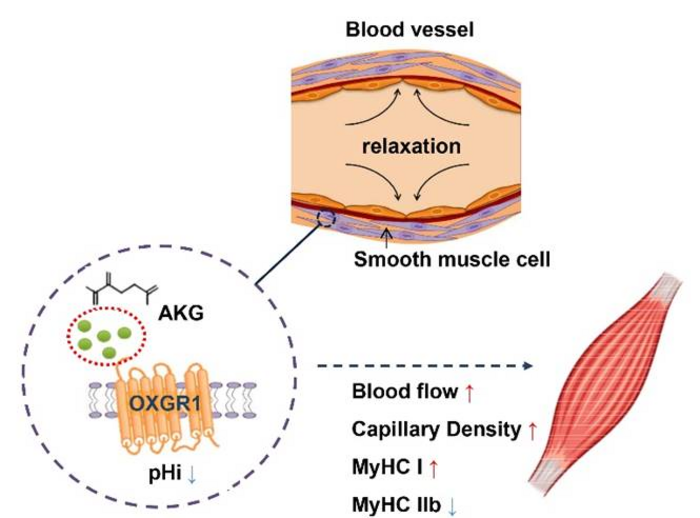Skeletal muscle is the largest metabolic organ in the body. It is composed of muscle fibers, blood vessels, nerves and connective tissue. In skeletal muscle, blood vessels are responsible for transporting oxygen, nutrients and metabolic wastes, which is very important in muscle development, hypertrophy and metabolic regulation.

Credit: Jinping Yang, Guli Xu, Yiming Xu, Pei Luo, Yexian Yuan, Lin Yao, Jingjing Zhou, Yunlong Zhu, Ishwari Gyawali, Chang Xu, Jinlong Feng, Zewei Ma, Yuxian Zeng, Songbo Wang, Ping Gao, Canjun Zhu, Qingyan Jiang, Gang Shu
Skeletal muscle is the largest metabolic organ in the body. It is composed of muscle fibers, blood vessels, nerves and connective tissue. In skeletal muscle, blood vessels are responsible for transporting oxygen, nutrients and metabolic wastes, which is very important in muscle development, hypertrophy and metabolic regulation.
Based on the metabolic characteristics, skeletal muscle fibers can be broadly classified as “slow-twitch” (type I) and “fast-twitch” (type II), where type I slow-switch fibers undergo slow oxidation. Type II fast-twitch fibers can be further classified into three major subtypes based on the differential expression of myosin heavy chain (MYH): type IIA (fast oxidizing muscle fibers), type IIX (intermediate muscle fibers), and type IIB (fast enzymatic muscle fibers), although it is generally accepted that humans do not have type IIB fibers.
In skeletal muscle, the type I slow oxidizing fibers have better blood perfusion and more capillary density. In humans, type I muscle fibers are associated with longer exercise endurance, while meat quality is directly related to the proportion of slow muscle fibers in livestock muscle.
During contraction, the skeletal muscle releases various metabolites, such as the end products of glycolysis, pyruvic acid (PA) and lactic acid (LA), as well as intermediate metabolites of the tricarboxylic acid (TCA) cycle, α-ketoglutarate (AKG) and succinate (SUC). While LA and SUC have been shown to regulate vasodilation, which allows tissues to receive abundant oxygen and nutrients, it is not known whether AKG performs the similar function.
AKG is an important intermediate metabolite of the TCA cycle that can be released during exercise. Previous studies have shown that AKG plays biological functions such as regulating energy metabolism, promoting osteogenesis, improving immunity, and prolonging life span of animal organism. Oxoglutarate receptor 1 (OXGR1) is an endogenous receptor of AKG mainly expressed in the tissues of nervous system, adrenal gland and reproductive system, but the expression of OXGR1 in skeletal muscle is relatively low. In a previous study published by Prof. Gang Shuang and Prof. Qingyan Jiang at South China Agricultural University, it is demonstrated that addition of AKG to drinking water can reduce fat deposition, as well as increase skeletal muscle mass. Consistently, the skeletal muscle underwent significant atrophy in mice with global knockout of OXGR1. So far, the expression and function of OXGR1 in skeletal muscle are unclear.
On 29 September 2022, the same group published a study in Life Metabolism entitled “AKG/OXGR1 promotes skeletal muscle blood flow and metabolism by relaxing vascular smooth muscle”, revealing that AKG/OXGR1 regulates skeletal muscle metabolism through relaxing vascular smooth muscle. This study reports for the first time that OXGR1 in skeletal muscle is mainly distributed in vascular smooth muscle of soleus muscle (slow oxidizing muscle). Using OXGR1 systemic knockout and vascular smooth muscle specific knockout mouse models, they found that OXGR1 is essential for type switching and metabolism of skeletal muscle. Further study revealed that AKG/OXGR1 signaling pathway can relax vascular smooth muscle by lowering intracellular pH in vascular smooth muscle. Moreover, additional AKG supplementation not only helps to promote muscle development, but also promotes the conversion and metabolism of skeletal muscle to oxidative muscle fibers, finally leading to improving exercise capacity or livestock meat quality (Figure 1).
This study provides novel insights into the nutritional regulation of AKG as a nutrient to improve the health and exercise capacity of specific populations (sedentary people or athletes), and the yield as well as quality of livestock meat.
###
Reference: Jinping Yang et al. (2022). AKG/OXGR1 promotes skeletal muscle blood flow and metabolism by relaxing vascular smooth muscle. Life Metabolism. https://doi.org/10.1093/lifemeta/loac026.
About Higher Education Press
Founded in May 1954, Higher Education Press Limited Company (HEP), affiliated with the Ministry of Education, is one of the earliest institutions committed to educational publishing after the establishment of P. R. China in 1949. After striving for six decades, HEP has developed into a major comprehensive publisher, with products in various forms and at different levels. Both for import and export, HEP has been striving to fill in the gap of domestic and foreign markets and meet the demand of global customers by collaborating with more than 200 partners throughout the world and selling products and services in 32 languages globally. Now, HEP ranks among China’s top publishers in terms of copyright export volume and the world’s top 50 largest publishing enterprises in terms of comprehensive strength.
About Life Metabolism
Life Metabolism is a fully open access, peer-reviewed journal that publishes one volume per year online, providing a platform for the publication of works of high significance and broad interest in all areas of metabolism. Life Metabolism welcomes several different article types, including original article, review article, research highlight, letter, editorial, perspective, and so on. Once a paper is accepted, Life Metabolism can publish a precopyedited, preproofed version of the paper online within 48 hours of receiving a signed licence, and this will be replaced by a copyedited, proofed version of the paper as soon as it is ready. The Editors-in-Chief are professors Peng Li at Tsinghua University and John R Speakman at University of Aberdeen, UK. In the first three years, there will be no publication costs for publishing in Life Metabolism, and Open Access fees will be waived.
Journal
Life Metabolism
DOI
10.1093/lifemeta/loac026
Method of Research
Experimental study
Subject of Research
Animal tissue samples
Article Title
AKG/OXGR1 promotes skeletal muscle blood flow and metabolism by relaxing vascular smooth muscle
Article Publication Date
29-Sep-2022




